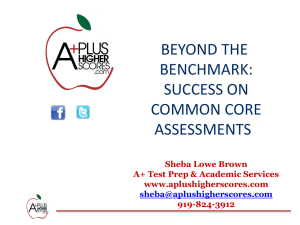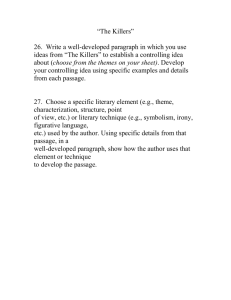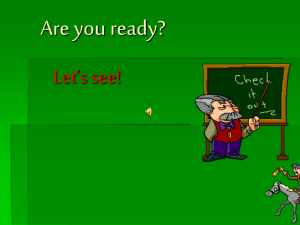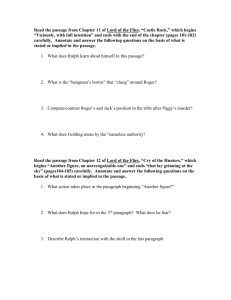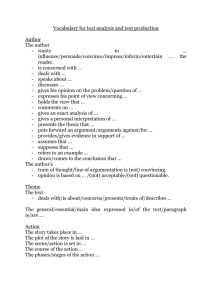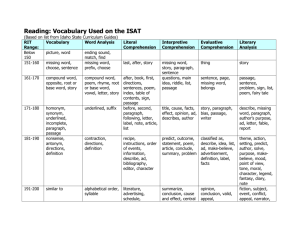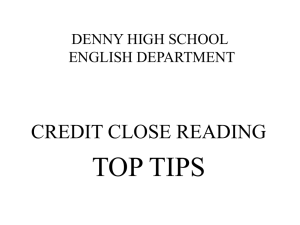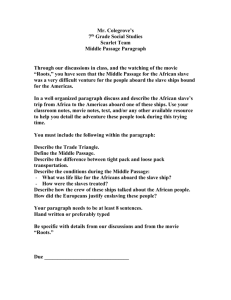Close Reading and Annotation
advertisement
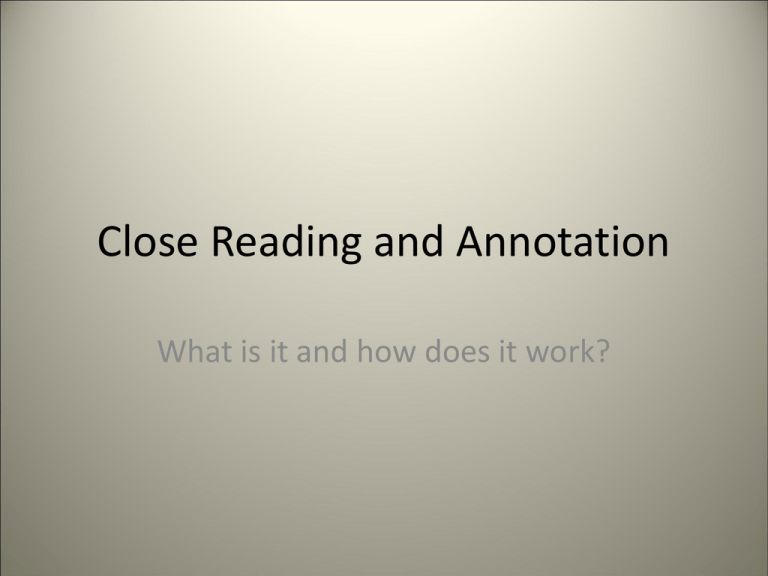
Close Reading and Annotation What is it and how does it work? Close Reading • Close reading is simply reading a small passage very closely. You are looking for details and literary techniques • ANALYSIS of a passage Summary vs. Analysis Summary • What happened • Who, what, when, where • The parts that everyone knows Analysis • What it means • WHY? • Goes beyond obvious points and looks deeper Analysis is looking for layers in a text Keep summary to no more than a few sentences in a paper! I have read the book, I know what happens. I want to read your analysis of it and hear your opinions! Things to look for… Title • The Hunt for Red October • Alice in Wonderland • The Odyssey • East of Eden • Anthem • The Jungle • Heart of Darkness • 20,000 Leagues Under the Sea • Jurassic Park • Jane Eure • Pygmalian • A Conneticut Yankee in King Arthur’s Court • Murder on the Orient Express Main Idea • • • • • • • Read the back Read the introduction Look at the cover Look at the book flaps Look at the Table of Contents Examine any illustrations Skim the first chapter Break it down! • Split the text up into paragraphs or other manageable chunks – By paragraph, speaker, setting, situation, etc. • Identify the main idea in each paragraph – Look for topic sentences – How does this paragraph’s main idea connect to and build on a previous paragraph’s ideas? Break it down! • Pause periodically to ‘translate’ – Put things in your own words – Repeat the action in more modern terms – Look up anything you don’t understand!! • Make connections – Are there any modern-day similarities? – Any similarities to your own experiences? Getting it… • Keep a list of questions – What is clear? What do you not understand? – Keep questions on a bookmark! • Use more than one method of note-taking – Read the text and your notes – Write down notes or re-copy your old ones – Speak: read the text out loud and listen to yourself – Listen: find the book on tape Annotating Taking notes on or about a book Why should I? • • • • • • Reading comprehension Notes for later assignments Homework/classwork Understanding Interest Practice How do I? • Best on the text itself, but also great to use a separate page • Take notes on questions you have, what’s going on in the story, words you don’t recognize, passages that are important, themes and symbols, etc. References • • • • • Title Chapter Line Page Paragraph • How will you find this passage again? Clarity points • What is clear to you? • What do I know? • What is happening that you don’t understand? • What words are you unfamiliar with? – Look them up and write the definitions in your notes Two-Column Response What does the author think? What do I think? • What are the author’s opinions? • Why does he think this way? • What has influenced this passage? • What are the character’s motivations? • What in the author’s history and personal life might have influenced this passage? • What do I think about the author’s opinions? • Why do I think the characters are acting in this particular way? • What do I think it means? • Do I agree with the author? • Why or why not? • What evidence or examples can I use from the text to support my ideas? • What is my own cultural perspective on this? *Spark • What occurs to you as you read this passage? • What kinds of ideas does it give you? • If you’re reading a critique or argument, what gaps in the author’s argument can you find? What kinds of things didn’t he consider? Sum it up. • • • • • What are the main points you just read? What was important? What did you learn? What was the author’s point? What techniques did the author use? – Satire, characterization, irony, symbolism, metaphor, etc. WHY?! • Character’s actions--- motivations • Character’s words--- intent or perspective • Character’s self--- personality, appearance, attitude, etc. – How do they appear to others? – What effect does this person have by being this way? • Effect on other characters • Effect on the reader Alice in Wonderland A Study in Scarlet

